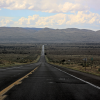At 11,306 feet, Mount Taylor is the highest peak in the San Mateo range, located about 15 miles northeast of Grants, New Mexico. In the winter its snow-capped peak is especially noticeable. During the Spanish rule of the region, the mountain was called Cebolleta (little onion). In 1849, after the U.S.-Mexico War, it was renamed after President Zachary Taylor. For the indigenous peoples of the area, Mount Taylor is a revered and spiritually significant location. In Navajo it is known as Tsoodzil (Turquoise Mountain) and is one of the four sacred mountains that mark the Navajo homeland.
According to Hillerman's version of Navajo mythology, First Man buried turquoise in this range, hence its symbolic blue color. Under Hillerman's interpretation, the chief of the Enemy Gods, Yé'iitsoh, once resided in this peak. When the Twin War Gods (Born for Water and Monster Slayer, sons of Changing Woman) killed Yé'iitsoh, his blood spilled down the slopes and hardened into the lava flows of El Malpais in the area surrounding Grants. The mountain features as a central and meaningful location for Blessingway and Enemyway ceremonies.











